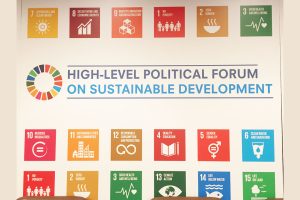By The Women’s Major Group Organizing Partners and Secretariat
While the SDGs were created in 2015 to address inequalities, the world today is – in many ways – worse off than it was then. Over the past several years we have witnessed rising inequality, the COVID-19 pandemic, increasing wars and militarism, and a worsening climate crisis, among other systemic setbacks to the sustainable development agenda.
In such states of “crisis,” the demands of the feminist movement are often deprioritized by decision makers behind more so-called “urgent needs.” In doing so, states fail to recognize that the human rights of women, girls, and gender-diverse people cut across all of the development goals, and that bringing attention back to gender inequality can actually tell us a lot about the systems we operate in.
“Women’s rights are not given naturally; these are the result of strong fights of our predecessors,” says Pille Tsopp-Pagan of the Women’s Support and Information Centre NPO in Estonia. “These can be removed with a split second as we have seen in Afghanistan – or most recently – in the United States. A balanced society is healthy and prosperous, and that can only be achieved by fulfilling the human rights of women, girls, and gender-diverse people around the world.”
During this year’s High-Level Political Forum on Sustainable Development (HLPF), as governments review progress towards SDG 5 on gender equality, the Women’s Major Group is calling for a systemic, human-rights based and gender-transformative approach to the implementation of all aspects of the 2030 Agenda, as well as COVID-19 recovery plans. These policies should be one and the same: COVID-19 recovery policies that push forward the 2030 Agenda, rather than undermine it. The pandemic must be seen as an opportunity for systems change, rather than an excuse to further derail progress on the SDGs.
Why is a human rights approach so critical, and what are the consequences of separating human rights and sustainable development? One illustration of this problematic phenomenon can be found in the issue of safe abortion. Denying people access to safe abortion denies them rights that are already enshrined in human rights frameworks (such as CEDAW) – such as the right to healthcare, to privacy, and to remain free from cruel or inhumane treatment.
We know that reducing maternal mortality will not be possible without safe and accessible abortion services. Yet, abortion access is not included in the sexual and reproductive rights (SRHR) indicators within SDG 5, and remains highly contested by many states. Thus, we see abortion being used as a lever issue to shape public opinion on reproductive rights, to maintain the status quo of patriarchy, and to place control in the hands of the state rather than to drive a rights-based development, which centers bodily autonomy.
“When looking at reproductive needs and justice around the world, there are so many other things we must also consider – aspects such as maternity leave and childcare access,” said ARROW Executive Director Siva Thanenthiran during an official Women’s Major Group side event. “We see that the reproductive rights indicators are not adequate, and that we need a more holistic understanding of how a person’s reproductive rights are realized.”
Similarly, recognition of the rights to land and resources – rights that are less clearly protected in core human rights treaties – are fundamental to a host of established human rights, such as the right to food, water, housing, and culture, as well as the ongoing fight to curb climate change. Thus, we see that the need for a more systemic and people-centered approach extends beyond individual issues, to all 17 of the SDGs. Though it may seem a daunting task, the interlinked nature of the goals means that our action in one can catalyze action in others, if they originate from an intersectional perspective. Just as a crisis in one area affects so many different aspects of our lives, holistic solutions can serve to heal interrelated problems as well. For this to happen, solutions must be rights-based, gender-transformative, and locally driven – including communities affected by decision making.
Ultimately, governments and the international development community must recognize that human rights must be at the center of any development agenda, that these are not in opposition to one another, but are necessary for the transformative change the world needs.

